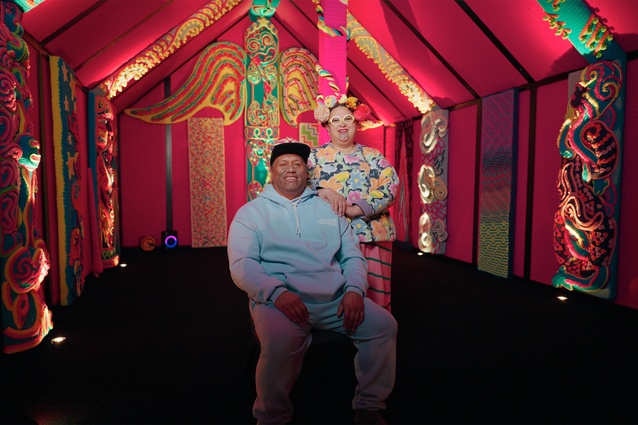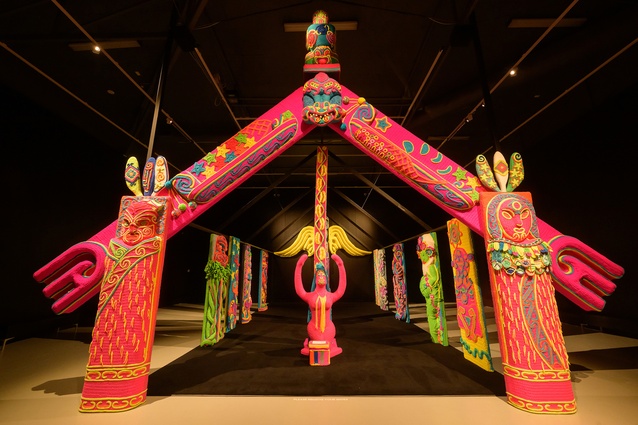Whare brings joy, love and deep connection
A brightly crocheted, full-scale wharenui or Māori meeting house aptly named Wharenui Harikoa ‘House of Joy’ opens next month at Waikato Museum. The immersive artwork uses the symbolic act of weaving, the traditional built forms and decoration of the artists’ tupuna (ancestors) and the sensory effects of vivid colour to create a tangible representation of intergenerational trauma transformed into deeply felt joy and love.
The artwork by husband and wife duo Lissy Robinson-Cole (Ngāti Hine, Ngāti Kahu) and Rudi Robinson (Ngāti Paoa, Ngaruahine, Te Arawa, Waikato ki Tai) elicited emotional reactions when displayed only in part last year at Objectspace in Auckland and is expected to evoke even stronger emotions in its complete form, when exhibited only for the second time, due to the sheer scale of the piece.
Says co-creator Robinson-Cole: “You know, people walk into the whare now and they cry. There is a lot of wairua (spiritual energy) in this space and the aroha (love) of thousands of people.”
The wharenui measures 9.3m on its longest side, took over three years to complete, around 5000 balls of wool, and saw 51,000 thousand people through at its first showing at The Dowse Art Museum in Lower Hutt last year.
Robinson-Cole describes entering the whare as “feeling like a warm embrace from your aunty or nanny” – an effect no doubt heightened by the materiality of polystyrene base panels covered with a thick, woolly, crocheted overlay that creates a sense of soft enclosure and prompts a visceral response.
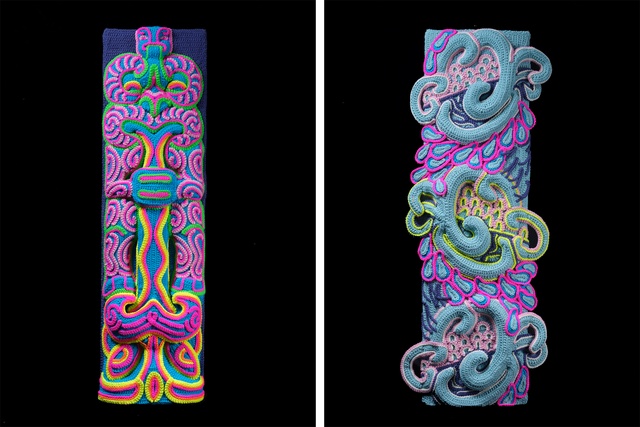
Says Robinson-Cole of the wharenui’s role in spreading aroha: “For whatever reason, we’ve come together at this moment in a time when there’s so much division in our world. People are wanting connection, they are wanting to know that there’s hope, they’re wanting to know that there are spaces and people and places for healing, for love, for connecting to one another. I feel like this wharenui has come at exactly the right time in which to share a universal message, but told in a uniquely and beautiful Māori way.”
The art of crocheting – traditionally relegated to the domestic or feminine crafts – is seen here in a bold new light, in the strong forms of the amo, maihi, poupou, tekoteko, tukutuku panels and adorned pou tokomanawa of the wharenui. Says Robinson of this reinterpretation: “This is a very new art form. It’s a mixture of crocheting and of toi whakairo (carving). During this journey, we’ve had to come up with our own language that best suits us. All of our carvings have been in collaboration with other artists from all over Aotearoa and we also have panels which come from around the world.”
On the unique mix of traditional Māori whakairo and crochet, he says: “Not many artworks will take you back into the past when you remember your mum, your grandmother, and all those beautiful ones that used to crochet in the past. But it also takes you into the future of what our art forms could look like, because it’s not often you see a crocheted carved piece, or carved pou (post). So it takes you into that future and it opens your mind to what can be done – all in a single moment.”
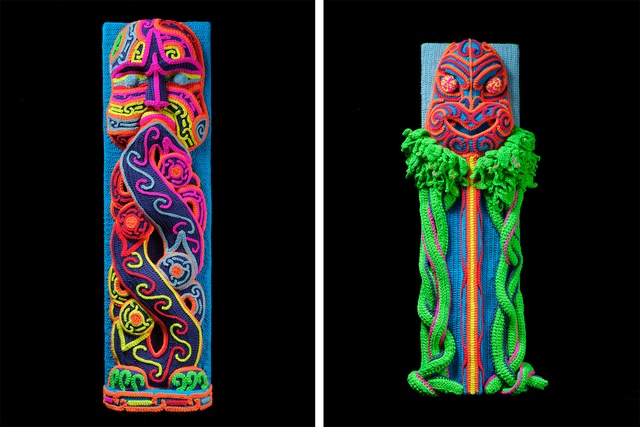
The pair have collaborated with four international artists: one from Iceland, a Puerto Rican crochet artist with a community in New York, another from Texas, and an artist who was instrumental in Lissy’s crochet practice – London Kay, who lives in Los Angeles.
Interwoven into this kaupapa are all of the stories surrounding Matariki, a constellation appearing in the sky in June or July that marks the lunar new year in the Māori calendar. Humankind’s universal connection to the stars was another factor that prompted their global vision for the art work and their intention to incorporate the vision of international artists.
“One thing that we found out quite early on in our crocheting is that the act of crochet is a universal act,” Robinson pints out. “From clothing to fishing nets for gathering kai, weaving is a universal language. So we talk about that invisible thread that connects us – the act of crochet connects us all in one way or another. That was another reason why crochet was just perfect for this kaupapa of Wharenui Harikoa.”
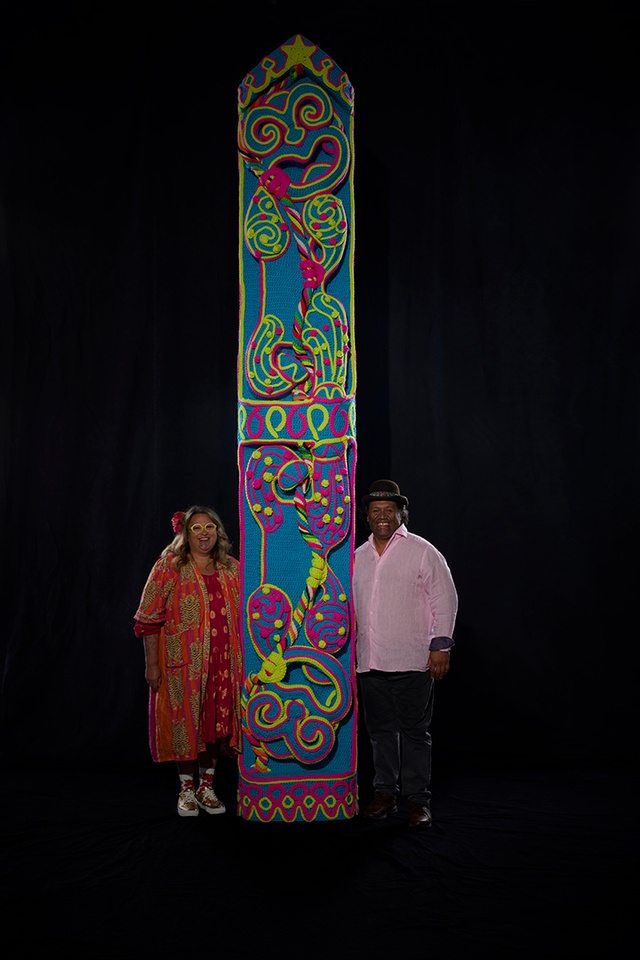
Wharenui Harikoa’s bright and joyful form has brought Māori toi (art) to the masses and (according to the artists) has made it more accessible – prompting questions and interest from people from all walks of life. One goal of the duo is to make sure its reach extends to those that need it most and, at the time of writing this piece, they were in talks with Mount Eden Prison about installing it there for a short period of time.
“There are talks of getting the wharenui inside the prison just to be that statement of healing, especially with our statistics for Māori men and women that are in our prisons at the moment. So that is something that we’re working on,” says Robinson.
Architecturally, Wharenui Harikoa demonstrates the transformative effects of hue saturation and colour on a space, the extremely emotive quality of soft furnishings when all-encompassing, the ability for spaces to heal and connect our past, present and futures, and how the traditional architectural forms of the Māori wharenui can be revitalised through a modern directive grounded in te ao Māori and the possibilities of new materials and technologies.
Wharenui Harikoa will be on display at Waikato Museum from 1 December 2023 to 17 March 2024. Entry is free (open 10am–5pm daily). More information can be found here.
For updates, follow Lissy and Rudi on instagram and head to lissycole.com to learn more about the artists’ kaupapa and artworks available and to offer your support.
Can’t make the exhibition? Experience the wharenui in 3D via the Wharenui Harikoa app. The app also has detailed imagery and information on each component of the whare for reference.

